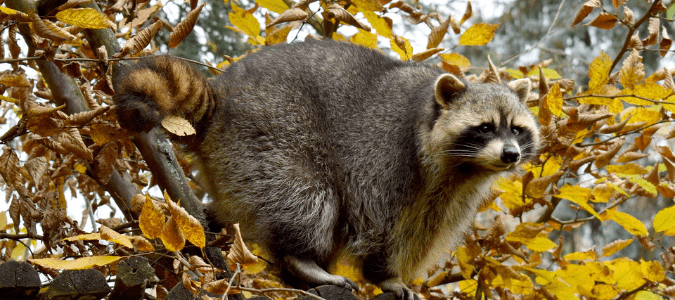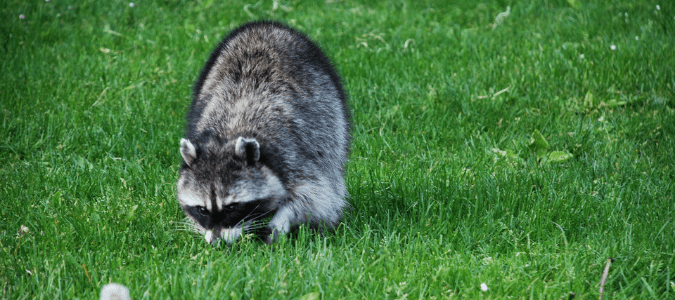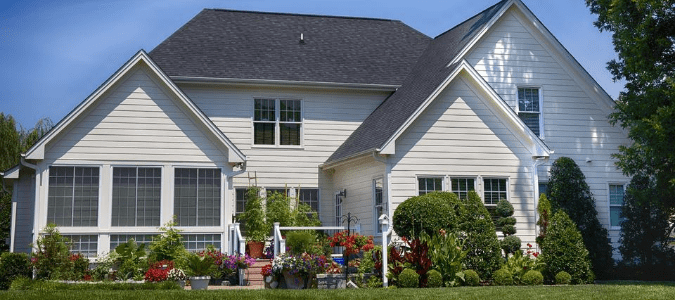
Are you hearing something going thump in the night? If so, this might mean a raccoon family is living rent-free in your attic or crawl space. Some of the first signs that you might have raccoons in your home include the sounds of an animal moving around in the attic or chimney.
Other ways homeowners often find out these animals have moved in include visible indications, such as pawprints or damage to their house’s shingles, electrical wiring or insulation. They might also notice an accumulation of nesting materials inside the house, a destroyed garden or debris around their property, such as dead birds, feces or scattered trash.
If you spot possible signs of a problem, some ways to check whether you have raccoons on your property instead of another pest include looking at the pawprints and scat the animal left behind. Raccoons leave hand-like prints with their five-fingered paws, and their droppings are usually around the same size as a cat’s. If you see tracks that are less “hand-like” or that have a “thumb” on the hind foot, you might have opossums instead of raccoons on your property.
Additionally, raccoons typically use the same area, such as a woodpile, as their latrine instead of defecating in different spots each time like many other pests. If raccoons are using a spot in your attic as their latrine, then you might notice an odor or a urine stain on the area of the ceiling beneath the latrine.
Homeowners can also look for damage to their garden or yard to help determine what kind pest they have on their property. Raccoons are more likely than possums to dig up your newly lain sod at night in search of grubs or worms. They also shred or roll up grass while searching for food, while skunks make cone-shaped holes when they dig.
Raccoons are adaptable and opportunistic, and they often use other animal’s spaces—including the attics of human homes—as their dens. While they don’t hibernate, they might spend several weeks or over a month in a den when it’s extremely cold outside. Additionally, mama raccoons might go into an attic or another den if they’re pregnant or trying to protect their litter of newborn babies.
If you’re hearing a tapping noise in your attic at night, you’re probably wondering how those creatures got there in the first place. Some of the ways that raccoons might get into your attic include through uncapped chimneys, broken vents, pet doors, loose boards and weak points in a structure like dormer junctions. They might also crawl down tree branches that are close to your roof and claw their way through siding or shingles to get into your attic.
If you have raccoons on your property, it can be extremely dangerous to try to deal with them on your own. Beyond the damage that raccoons can cause to your house while trying to get in or while building a den, they can also have several other negative impacts on your household. For one, they can harbor other pests like fleas and ticks, which can lead to an entirely different type of pest problem. To make matters worse, they can carry and transmit diseases and parasites through their bite or excrement, such as rabies, roundworm and E. coli that can make humans very sick.
Even healthy raccoons can attack or become aggressive towards pets and humans, especially if they’re trying to protect their babies or they’re cornered. A wildlife control specialist who has the training and experience to control these pests can help protect your family by using their expertise to remove raccoons for you, so you don’t have to worry about the negative consequences of dealing with a raccoon problem on your own.
One of the main ways that homeowners can prevent raccoons from taking up permanent residence on their property is to limit the animals’ food sources.

What Do Raccoons Eat?
Raccoons can survive on a wide range of foods. They can eat almost anything they can find, such as birds, other small animals, pet food, birdseed, corn, fruit, worms, nuts or even trash that they scavenge from a garbage can or compost pile.
If your trash or compost bin has a loose lid or you leave your garbage outside in an unsecured container, raccoons might see this as an invitation to move in with you. Other food sources that might attract raccoons to your property include unguarded gardens, uneaten pet food and ornamental ponds with fish. Also, never intentionally feed raccoons, since this might attract additional raccoons to your property. If a raccoon problem is left unattended, they might breed and multiply in your attic or home.
Some other steps homeowners can take to restrict a raccoon’s potential food sources include:
- waiting to put the trash out until the morning of pickup;
- if you must store your garbage outside, make sure your trash and compost cans have tight lids or use a heavy brick, stone, bungee cord or chain to secure them;
- use bird feeders that recapture fallen seeds, hang feeders in areas where raccoons can’t reach them like a wire or pole, and take the feeder inside during the night when raccoons most often look for food;
- keep smelly trash, such as scraps from fish and chicken meals, in the freezer until trash day to reduce the chance that the odor will attract raccoons and
- if your dog or another pet eats outside, clean up any uneaten food as soon as possible after mealtime.
Aside from limiting food sources, many homeowners wonder what else they can do to get rid of the raccoons on their property.

Does Raccoon Repellent Work?
There are many types of commercial raccoon repellent on the market and the internet has a range of ideas for homemade repellents, such as mothballs, coyote urine and hot sauce. Unfortunately, none of these products or home remedies have been scientifically proven to repel raccoons.
Even with techniques that might work temporarily to scare off raccoons like motion sensor lights or loud noises, these animals are often sly enough to adapt to get the food or shelter they want.
The best way to deal with raccoons from your attic, yard or other parts of your house or property is to contact a wildlife control specialist. These professionals know how to trap and remove raccoons and any other creatures that might be on your property and implement custom pest control measures that can help reduce the likelihood of another wildlife problem in the future.
There are a variety of reasons why you shouldn’t try to control a raccoon problem on your own. Raccoons might bite you, your children or pets if you corner them or they feel threatened. Additionally, in trapping a raccoon, you might accidentally separate a mother from her babies, which can create even bigger problems. The mother might damage your property even further if she tries to claw through an area to reach her litter, or the nursing babies might die inside your home once separated from their mother.
The best strategy for homeowners is to make their property unattractive to raccoons while they wait for a wildlife control specialist. Some of the preventative measures that homeowners can take include:
- raking up excess vegetation in your yard that raccoons might use as nesting material;
- making sure all your chimneys have an approved cap;
- trimming back branches that reach close to your home to keep raccoons off your roof;
- locking or blocking your pet doors at night and
- keeping garbage bins in a secure shelter if possible, and using only metal trash cans with animal-proof lids that will stay closed if a raccoon knocks them over.
Additionally, homeowners can inspect their house for any holes or potential entry points, such as spots under the porch or in the crawl space, damaged shingles, loose boards or broken vents. Raccoons can squeeze through holes as small as four to six inches. To make matters worse, they can use their paws to undo simple barriers or latches and to enlarge smaller openings.
Before sealing up holes, it’s critical to make sure there aren’t already raccoons or other critters living in your home, so you don’t accidentally trap these creatures inside. One way to do this is with what’s called “the newspaper test”. You can either tape a sheet of paper over the hole or obstruct it with wadded up newspaper. Leave the paper there for a few days, then check to see if anything has disturbed it.
If it’s right where you left it when you check on it, you likely don’t have raccoons living in your home and you should be safe to repair the holes and seal the potential entry points that you found. For smaller holes, homeowners can typically use expanding foam or insulation to fill in any gaps.
With larger damage, such as rotten wood, it’s essential to use quality solid materials for these repairs, such as wire mesh that’s at least 10-gauge and plywood that’s at least a half-inch thick. When securing a crawl space, it’s also important for homeowners to bury wire mesh deep below the soil to discourage digging. Otherwise, strong and crafty raccoons might be able to tear through these barriers or figure out how to get around them.
If you’re uncomfortable making these repairs or you’re concerned about accidentally trapping a raccoon inside your home, it’s always best to contact a wildlife control specialist. They can help ease your stress by taking care of all these issues for you. Additionally, these highly trained professionals will be able to locate entry points you would not have even though of and can provide you with ongoing services to prevent and other types of household or yard pests.
ABC Can Remove Raccoons and Prevent Their Return
There are a variety of factors that contribute to the stressful experience of dealing with a raccoon problem, whether you have raccoons in your attic or on another part of your property. When you contact ABC Home & Commercial Services, you can have peace of mind knowing that we will remove all of the unwanted creatures on your property before sealing up entry points. Also, we offer ongoing pest control that allows us to catch any signs of pest activity of any type before a population of problematic bugs or critters can become established.
